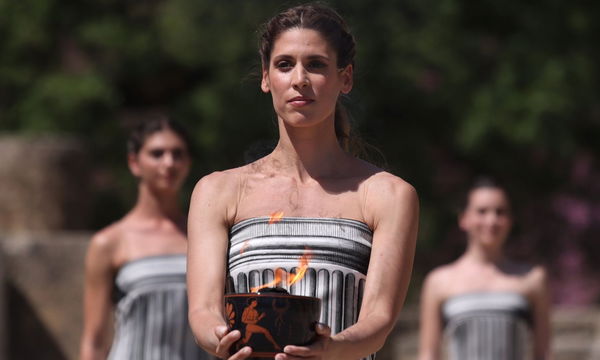What Will Happen to Paris Olympics 2024 Torch After Closing Ceremony?

Follow Us

The Paris 2024 Olympic torch lit up in a traditional ceremony this Tuesday, marking the countdown to the games starting on July 26th. Greek actress Mary Mina played the role of high priestess, using a backup flame because of cloudy skies. This torch will eventually light the benevolent Olympic flame in Paris at the opening ceremony.
The flame represents friendship and peace, linking the modern Olympics to their ancient roots since the 1936 Berlin Games. After starting its journey in Greece, it will pass through historic sites for 11 days before reaching Paris. But what happens to the flame after the Paris games?
The fate of the Paris Olympic flame – a resplendent paragon of tradition and hope
ADVERTISEMENT
Article continues below this ad
Throughout the duration of the Olympic Games, the torch remains ablaze. A standby flame, kindled from the same sacred embers as the primary torch, stands ready should the need arise to rekindle the spirit of the Games. However, once the final medal is awarded and the cheers of victory fade into memory, the Olympic torch meets its end. In a somewhat anticlimactic conclusion, the flame that once symbolized unity is extinguished, signaling the close of yet another chapter in Olympic history.

ADVERTISEMENT
Article continues below this ad
Trending

Desperate to Escape Dubai, Floyd Mayweather Jr. Gets Unexpected Offer for Help After Gervonta Davis’ Claims on Hostage Situation
April 30, 2024 07:23 PM EDT

NASCAR Rumor: Kyle Busch Could Fulfill Shattered Indy 500 Dream as ‘Chase Elliott 2.0’ Triggers Controversial Fallout
April 30, 2024 04:32 AM EDT

Bucks Injury Report: Game 6 Return for Giannis Antetokounmpo and Damian Lillard Looks Plausible After Miraculous Win
May 01, 2024 06:21 AM EDT

After Greg Norman’s 5-Word Hint, Viktor Hovland Adds Fuel to Fire With Glaring PGA Tour Snub
April 29, 2024 05:00 PM EDT

Madrid Open: Disappointed Coco Gauff Fans Demand Rightful Streaming of Her Intense Encounter Against Madison Keys
April 29, 2024 06:39 PM EDT
Get instantly notified of the hottest Olympics stories via Google! Click on Follow Us and Tap the Blue Star.

Follow Us
As the flame fades, the host nation breathes a collective sigh of relief, while the torch’s journey concludes, paving the way for the next host to take up the mantle of Olympic anticipation. In the aftermath of the Games, anticipation wanes until the next torch relay ignites the world’s excitement once more. However, the origins of this ritual extend far beyond the modern era, reaching back to the venerable practices of the Greeks.
From old beliefs to new discoveries, the journey of flames
In antiquity, fire held profound significance for the Greeks, woven intricately into their religious customs. At the hallowed grounds of Olympia, where the inaugural Olympic Games took place, an eternal flame flickered upon the altar of the revered goddess Hestia. This sacred fire, symbolizing purity and divine blessing, found resonance not only in the temple of Hestia but also in the sanctuaries dedicated to Zeus and Hera.
ADVERTISEMENT
Article continues below this ad
Yesterday, amidst the remnants of a temple venerating Hera, the modern rendition of the flame-lighting ceremony unfolds, with a skilled actress assuming the role of high priestess. Employing a parabolic dish, reminiscent of ancient Greek techniques, she harnesses the sun’s rays to kindle the flame, ensuring its continuity even under overcast skies. The journey of the flame embarks upon a symbolic odyssey, commencing from its genesis in Olympia. Enshrined within an urn, it begins its pilgrimage to the Coubertin Grove, paying homage to Pierre de Coubertin, the visionary behind the rejuvenation of the Olympic movement.
As the flame passes from bearer to bearer, traversing the historic landscapes of Greece, it heralds the forthcoming spectacle of unity and athleticism. On April 26, amidst the grandeur of Athens’ Panathenaic Stadium, the flame transitions into French custody, marking the commencement of its transcontinental voyage. Guided by tradition and meticulous planning, the flame’s luminous passage illuminates the collective spirit of nations.
Edited by:

Himanshu Sridhar
